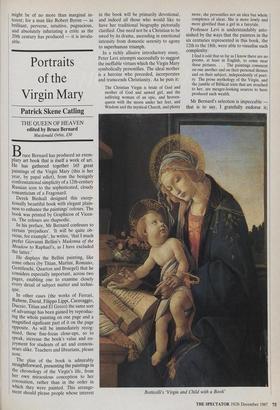Portraits of the Virgin Mary
Patrick Skene Catling
THE QUEEN OF HEAVEN edited by Bruce Bernard Macdonald Orbis, £30 Bnice Bernard has produced an exem- plary art book that is itself a work of art. He has gathered together 165 great paintings of the Virgin Mary (this is her year, by papal edict), from the benignly confrontational simplicity of a 12th-century Russian icon to the sophisticated, cloudy romanticism of a Fragonard.
Derek Birdsall designed this excep- tionally beautiful book with elegant plain- ness to enhance the paintings' colours. The book was printed by Graphicon of Vicen- za. The colours are rhapsodic.
In his preface, Mr Bernard confesses to certain 'prejudices'. 'It will be quite ob- vious, for example', he writes, 'that I much prefer Giovanni Bellini's Madonna of the Meadow to Raphael's, as I have excluded the latter.'
He displays the Bellini painting, like some others (by Titian, Martini, Romano, Gentileschi, Quarton and Bruegel) that he considers especially important, across two pages, enabling one to examine closely every detail of subject matter and techni- que.
In other cases (the works of Ferrari, Rubens, David, Filippo Lippi, Caravaggio, Duccio, Titian and El Greco) the same sort of advantage has been gained by reproduc- ing the whole painting on one page and a magnified signficant part of it on the page opposite. As will be immediately recog- nised, these fine-focus close-ups, so to speak, increase the book's value and en- joyment for students of art and connois- seurs alike. Teachers and librarians, please note.
The plan of the book is admirably straightforward, presenting the paintings in the chronology of the Virgin's life, from her own miraculous conception to her coronation, rather than in the order in which they were painted. This arrange- ment should please people whose interest in the book will be primarily devotional, and indeed all those who would like to have her traditional biography pictorially clarified. One need not be a Christian to be awed by its drama, ascending in emotional intensity from domestic serenity to agony to superhuman triumph.
In a richly allusive introductory essay, Peter Levi attempts successfully to suggest the ineffable virtues which the Virgin Mary symbolically personifies. The ideal mother is a heroine who preceded, incorporates and transcends Christianity. As he puts it:
The Christian Virgin is bride of God and mother of God and unwed girl, and the suffering woman of an epic, and heaven- queen with the moon under her feet, and Wisdom and the mystical Church, and plenty more; she personifies not an idea but whole complexes of ideas. She is more lowly and more glorified than a girl in a fairytale.
Professor Levi is understandably asto- nished by the ways that the painters in the six centuries represented in this book, the 12th to the 18th, were able to visualise such complexity:
I find it odd that so far as I know there are no poems, at least in English, to come near these pictures. . . . The paintings comment on one another and on their personal themes and on their subject, independently of poet- ry. The prose mythology of the Virgin, and the jumble of Biblical texts that are attached to her, are meagre-looking sources to have produced such wealth.
Mr Bernard's selection is impeccable that is to say, I gratefully endorse it; Botticelli's 'Virgin and Child with a Book' judged by numbers, he favours Bellini, with Botticelli a close second. However, Botticelli's Virgin and Child with a Book is the painting he chose to reproduce on the cover, and, once it was chosen, he says, 'it seemed almost impossible to consider any other.'
The way it combines what is close to what we know as glamour with the humour of the Christ Child finding his mother in a trance and unable to answer any of his questions, while yet remaining a sacred image, is one of the riddles that this collection sometimes poses.
The mother's solemn expression is easily understood when one notices that she has apparently just been contemplating her son's fate, the three nails he seems to hold and the crown of thorns encircling his wrist (painted the same dark gold as his halo), which, evidently, only she can see.
The Madonna's face characteristically is clouded by premonitory melancholy, most remarkably in two lovely paintings of The Virgin and Child by Andrea Mantegna (1430-1506), in which she protectively holds her sleeping baby and appears to be mourning him as if he were already dead. In Bellini's Virgin and Child with a Greek Inscription the child is awake and seems dolefully to share his mother's vision.
As Christopher Lloyd points out in his excellent appreciative historical notes, which give the provenance, probable date, medium, compositional analysis and aes- thetic significance of every painting, 'it is sometimes argued that the sleeping Christ Child anticipates the dead Christ of the Pieta', 'but', he adds consolingly, 'this can hardly always be the case.'
Actually, though, the sad Madonnas all look so much more intelligent than the ones who smile, such as Correggio's and that lumpish young woman of Diirer's. Perhaps sadness is less difficult to paint than joy.
For whatever reason, two of the finest paintings in Mr Bernard's collection are the sombrely ochreous Pieta attributed to Enguerrand Quarton and Bruegel's pro- foundly obfuscated Death of the Virgin, which, Mr Lloyd observes, anticipates Rembrandt.
It is a relief to reach the happy ending — Titian's glorious red and gold Assumption of the Virgin and Velasquez's Coronation of the Virgin by the Trinity. Here are Christmas and Easter in one splendid volume.











































































































 Previous page
Previous page